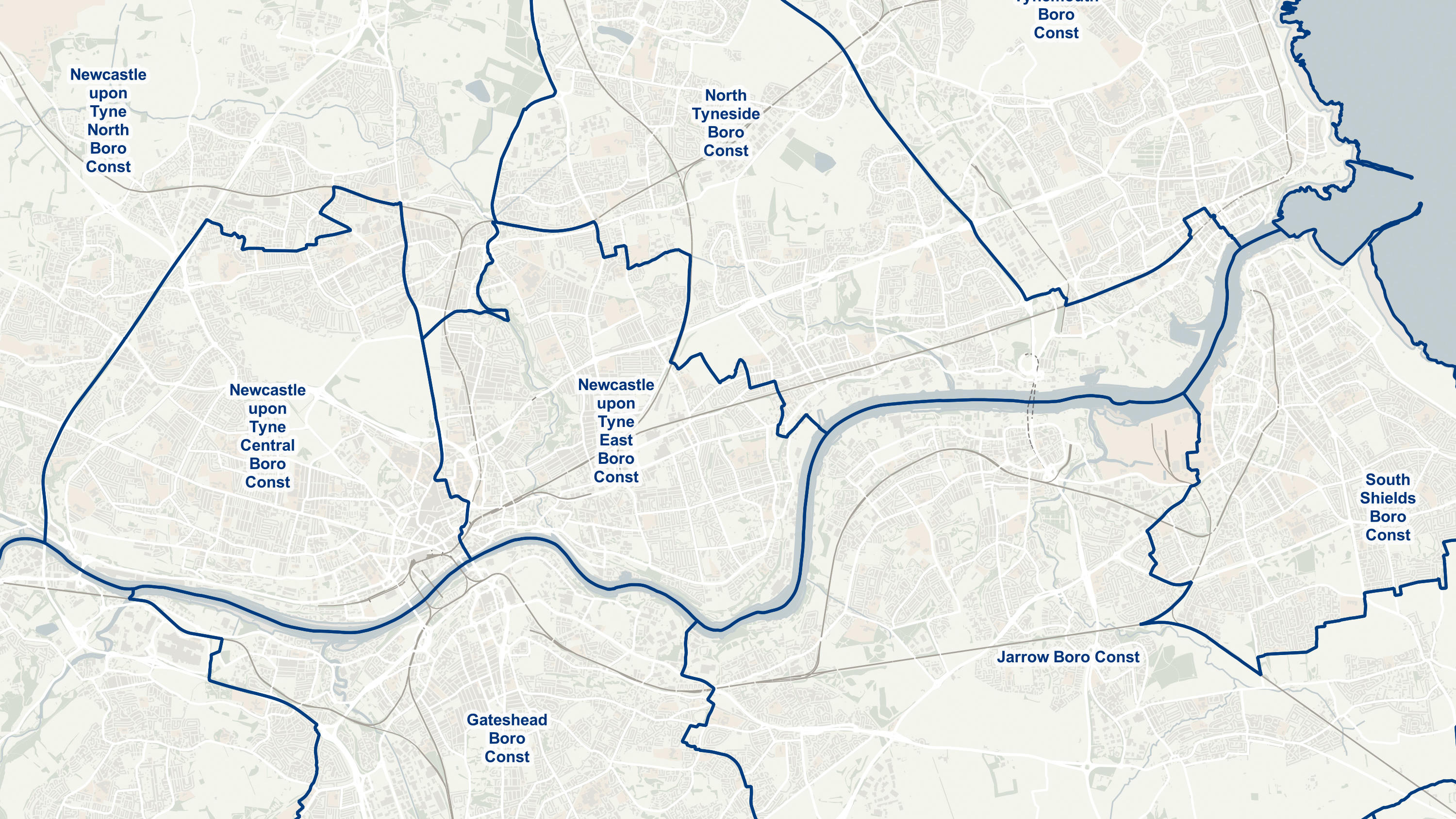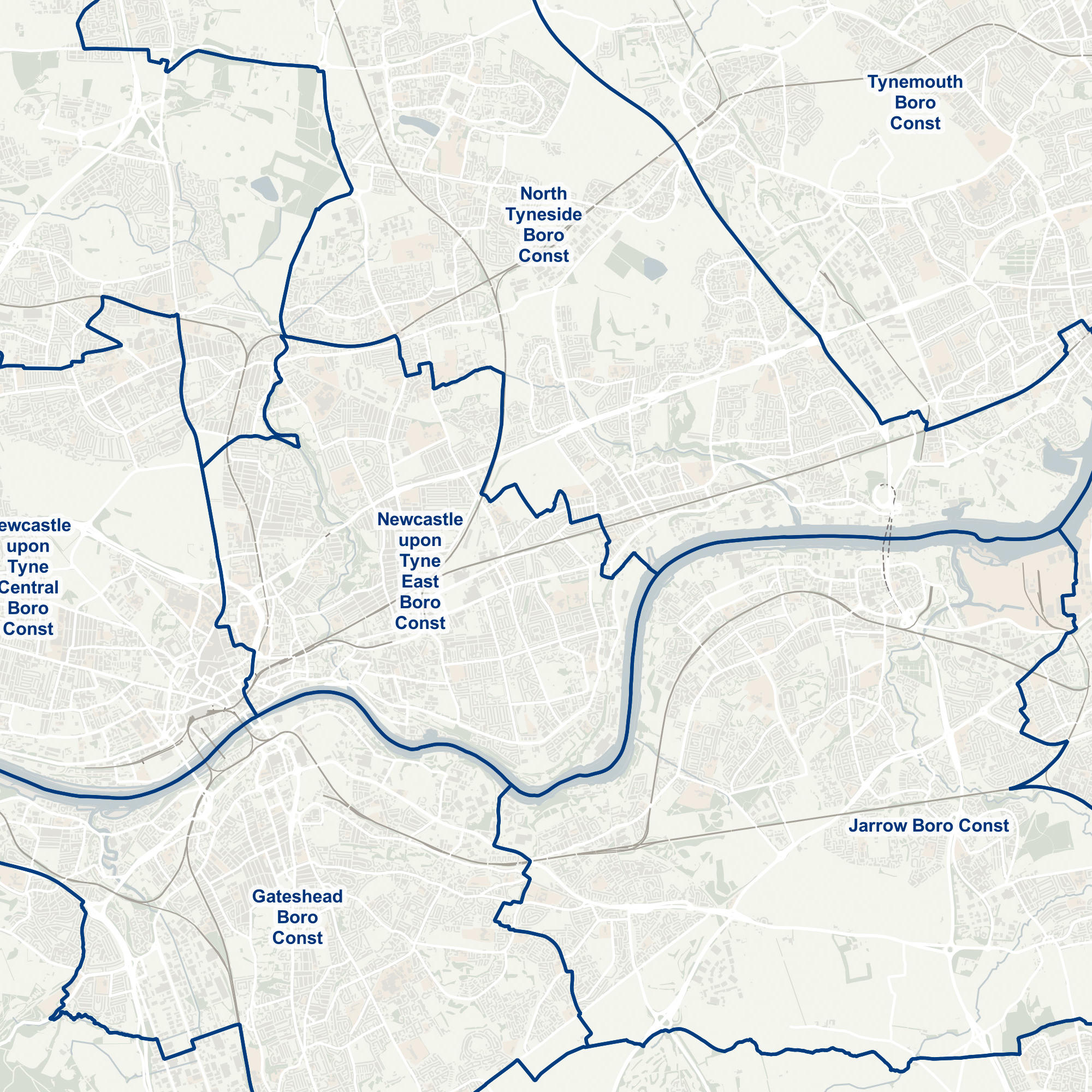Boundary-Line
From parliamentary constituencies to council wards, Boundary-Line maps every administrative boundary in detail for you. And what's more, it's completely free to download and use.
This product is updated twice a year
From parliamentary constituencies to council wards, Boundary-Line maps every administrative boundary in detail for you. And what's more, it's completely free to download and use.
This product is updated twice a year


Public bodies release a wealth of data via data.gov.uk, census results and other sources. By illustrating your analysis on maps created with Boundary-Line, you'll be able to highlight the social and economic trends shaping changes in how we live and work.
As an addition to the core Boundary-Line product, which is updated twice a year, you can download data showing historical county boundaries from the late 19th Century. This is ideal for historians who need to analyse old census records and archives.
Monitoring outcomes by area is key for public bodies. Boundary-Line gives you a robust analytical framework to ensure the right communities get the right resources.
Mapped at a scale of 1:10 000, Boundary-Line is quality-assured to the same standard as our premium products. But since it's covered by the Open Government Licence (OGL), you can download it for free and use it in a wide range of ways.
Bring statistics to life, for academics or policy-makers
Boundary-Line brings the statistics in your reports to life. It lets you show differences between regions or councils using easy-to-read shaded maps.
Individual properties
When you're consulting on updating boundaries to take account of population change, Boundary-Line lets you show on a map where the line's being drawn, right down to the level of individual properties.
Here are the future Westminster Constituency Boundaries of England, Scotland, and Wales as approved by the Privy Council of the House of Commons on 15th November 2023:
A Polling Districts layer is included as a supplementary file within the product. We do not routinely maintain this layer as uptake has been limited and the vast majority of areas are frozen since 2016 when information was sourced through the Boundaries Commission for England (BCE). Changes to Polling Districts are notified exclusively to BCE and OS do not receive the change information from local authorities directly.
In 2021, we completed a task for the BCE to update the following areas all of which are Operational before or on 5 May 2022:
|
Barking & Dagenham |
Barnet |
Barnsley |
Basingstoke & Deane |
|
Bexley |
Birmingham |
Bolton |
Bradford |
|
Bromley |
Buckinghamshire |
Bury |
Calderdale |
|
Corby |
Coventry |
Croydon |
Doncaster |
|
Greenwich |
Hackney |
Hammersmith & Fulham |
Harrow |
|
Havering |
Hillingdon |
Hounslow |
Islington |
|
Kensington & Chelsea |
Kettering |
Kingston upon Thames |
Kirklees |
|
Knowsley |
Lambeth |
Leeds |
Lewisham |
|
Liverpool |
Manchester |
Merton |
Newcastle upon Tyne |
|
Newham |
North Northamptonshire |
North Tyneside |
Oldham |
|
Plymouth |
Redbridge |
Richmond upon Thames |
Rochdale |
|
Salford |
Sandwell |
Sefton |
Sheffield |
|
South Lakeland |
South Northamptonshire |
South Tyneside |
Southwark |
|
St. Helens |
Stockport |
Sutton |
Tameside |
|
Tower Hamlets |
Trafford |
Walsall |
Wandsworth |
|
West Berkshire |
West Northamptonshire |
Wirral |
Wolverhampton |
A polling district is a geographical area created by local authorities to assist the administrative process of running an election. Each ward or electoral division in England and Wales is divided into one or more polling districts.
In England, each parish is to be a separate polling district and, in Wales, each community should be a separate polling district, unless there are special circumstances. This means that a parish or community must not be in a polling district which has a part of either a different parish or community within it, or any un-parished part of the local authority area within it, unless special circumstances apply. Those special circumstances could arise if, for example, the parish/community has only a small number of electors and it is not practicable for the parish/community to be its own polling district
The Welsh equivalent (community wards) are also released as a supplementary data set, the Scottish equivalent are not supplied.
Here are boundaries of historic counties such as Westmorland, Radnorshire and Wigtownshire from the late Nineteenth Century. View and download for free:
The links above represent counties based on historic records and mapping circa 1888 and using the primary sources of the Local Government (England and Wales) Act 1888, the Local Government (Scotland) Act 1889 and the Sheriffs Act 1887. Learn more:
Here are the ceremonial county boundaries of Great Britain, such as Bedfordshire, Berkshire and the West Midlands. View and download for free:
Boundary-Line contains all the current (operative) administrative and electoral boundaries for Great Britain.
They consist of:
The product also contains mean high water mark (MHW), extent of realm (EOR) also census agency codes supplied by the Office for National Statistics (ONS), and the National Records of Scotland (NRS).
Civil parish wards are not shown in Boundary-Line. We only show the parish, we do not show the internal parish wards or any associated council references.
We have polygons in the parish data that do not have any attribution – no records attached, formally known as Non Civil Parishes (NCP's- i.e. Non Parished Areas), these ‘blank’ polygons are shown to complete the parish layer, because a polygon dataset cannot have ‘gaps’.
The length of time changes to new parishes take to be reflected in Boundary-Line data is based on the following information.
Parishes are created and managed separately from the other electoral and administrative boundaries represented in Boundary-Line. To amend a parish, the Parish councillors make an appropriate submission to their Local Authority.
The information relating to the parish changes should then be sent to Ordnance Survey directly from the Local Authorities, as they are required to inform Ordnance Survey of any name changes under the Local Government Act (1972) and the more recent Local Government and Public Involvement in Health Act (2007) for name and boundary alignments.
On receipt of the parish update information we would expect to capture that in the appropriate Boundary-Line 6 monthly scheduled releases. We can only amend the parish boundaries after receiving this official notification.
Additional parish information updates will be more frequently available, once confirmation is received, as the large scale OS MasterMap Topography boundary information is continuously updated.
Boundary-Line is a separate product from OS MasterMap Topography; the Topography Layer is captured at a different scale and from a different production system.
Only OSMM Topography Layer currently holds the definitive and more accurate boundary information as the boundaries are mered (aligned to) real-world features on the ground. Captured at mapping scales of 1:1250 (for urban areas), 1:2500 (for rural) and 1:10k (for mountain and moorland). All electoral and administrative boundaries are contained within the OSMM Topographic layer. It is a point and line structured dataset and does not contain polygons.
Boundary-Line is captured against a lower resolution mapping backdrop and the boundaries are captured to represent the data at a nominal 1:10000 viewing scale. The process of generalising the data may have caused some features to be moved from their true ground position for the purpose of map clarity. The result being that Boundary-Line and the OSMM Topographic boundaries are not always coincident (when overlaid they will not always have the same alignment). Boundary- Line is a polygon structured dataset.
N.B. these datasets are not designed to be used together as they will not give exact replication of boundary position.
The data is supplied by named files, all the named files include all of the other sub‑levels of electoral boundaries that belong under that high level administration (for example, County file) will have the named county, district, district ward, civil parish, county ED contained within. Unitary authorities will have named unitary authority, unitary authority ward or unitary authority ED as appropriate, civil parish where appropriate, together with community in Wales. The nested structure is only available in ESRI Shapefile.
This is a simplified file structure supplying the boundaries as individual files, for example, County file contains only counties, and unitary authorities file contains just unitary authorities. The layered structure is only available in ESRI Shapefile.
Area values of each polygon in Boundary‑Line include the Extent Of Realm (EOR) limit. The total area values are quoted to the current Department for Communities and Local Government (DCLG) specification of 0.001 hectare.
However, other government statistical department data is based on Standard Area Measurements (SAM), which only includes the land area contained within a polygon deleting any inland hydrology or EOR areas.
The boundaries shown in OS MasterMap Topography Layer do not represent legal property extents and are only representative of the electoral and administrative boundaries. For ‘property extents’ it would be advisable to contact Land Registry directly.
There may be three reasons for the boundary at a particular location not aligning where it was presumed it should be:
Boundary-Line is updated and released twice a year, in May and October. Each release will have all the new and amended boundaries that are operative (live) within a one year period (1st May to 31st April). We only show the current operative boundaries in the Boundary-Line product.
However, due to market requirements we have supplied alongside the Boundary-Line product future dated (pre operative) Westminster Parliamentary boundaries. These supplementary files will only be included in the Boundary-Line product at the next suitable release, after the General Election has taken place. This future dated boundary data is part of the specification and so is included in the Boundary-Line licence fee.
Change Only Update data is not available for this product due to the current and future boundary complex relationships within the production system.
The EOR is the seaward limit of the administrative units. The boundary alignment is digitised to the Mean Low Water (springs) MLWS) to represent the seaward extent within Boundary-Line.
Boundary-Line does not show all items that ‘extend’ into the sea. We show structures such as a pier, seaward extension or structure in the sea that has been included in a specific Act of Parliament, and or are a permanent and solid structure (i.e. Brighton marina). Piers and extensions that are elevated over the sea; on stilts or floating pontoons, will only be included if they are identified as being part of the local authority area by an Act of Parliament. Structures in the sea can be separate or joined to the mainland; if they are joined to the mainland they are generally included in local government and parliamentary areas. If separate they are not included unless they are included therein by legislation for example Torbay and Bristol.
Ready to get started with OS data?
Take the next step by signing up to the OS Data Hub and create your first project today.

For further help about how our data can transform your organisation, contact us today
Contact us